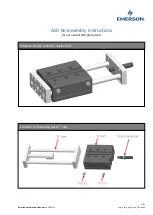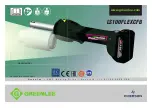
408-10414
Rev
D
3
of 6
3.
CRIMPING PROCEDURE
Refer to the table at
http://tooling.te.com/data.asp
to ensure that the wire intended for use is compatible with
the wire size and insulation diameter specified in the table. Strip the wire to the length indicated in the table.
CAUTION
Do NOT cut or nick the wire strands during wire stripping.
3.1.
Proceed as follows:
1. Hold the tool so that the FRONT side is facing you.
2. Ensure that the tool ratchet is released by squeezing the tool handles and allowing them to open
FULLY.
3. Be sure the flip locator is in the load position (see Figure 3). Hold the contact by the wire and
insulation barrel, push the contact retaining plate and insert the contact receptacle into the flip locator
so that the top of the contact (opening for the wire) faces away from the tool. Be sure to insert the
contact in the proper nest according to the wire size on the front of the tool. Once the contact is
loaded, release the contact retaining plate and flip the locator up 90 degrees.
Figure 3
4. Squeeze the tool handles together until the insulation anvil starts entry into the insulation crimper
(usually two ratchet clicks). Do NOT deform the insulation barrel or wire barrel.
5. Insert a properly stripped wire through the insulation stop slot and into the wire barrel of the contact
until the insulation butts against the insulation stop.
6. Holding wire in place, crimp contact to the wire by squeezing the tool handles together until the ratchet
releases.
7. Allow tool handles to open FULLY. Depress the Contact Retaining Plate and remove the contact.
3.2.
Insulation Adjustment Procedure
On many tools, the insulation barrel crimp height is regulated by the insulation adjustment knob (see Figure 1).
The insulation crimp should hold the insulation firmly without cutting into the insulation.
To determine the proper insulation crimp setting, test crimp a loose piece contact using the setting which
corresponds to the insulation diameter: (1) small; (2) and (3) medium; or (4) large. If the crimped insulation
barrel is too tight or loose, change the setting by pulling out and rotating the adjustment knob to the desired
setting.
























